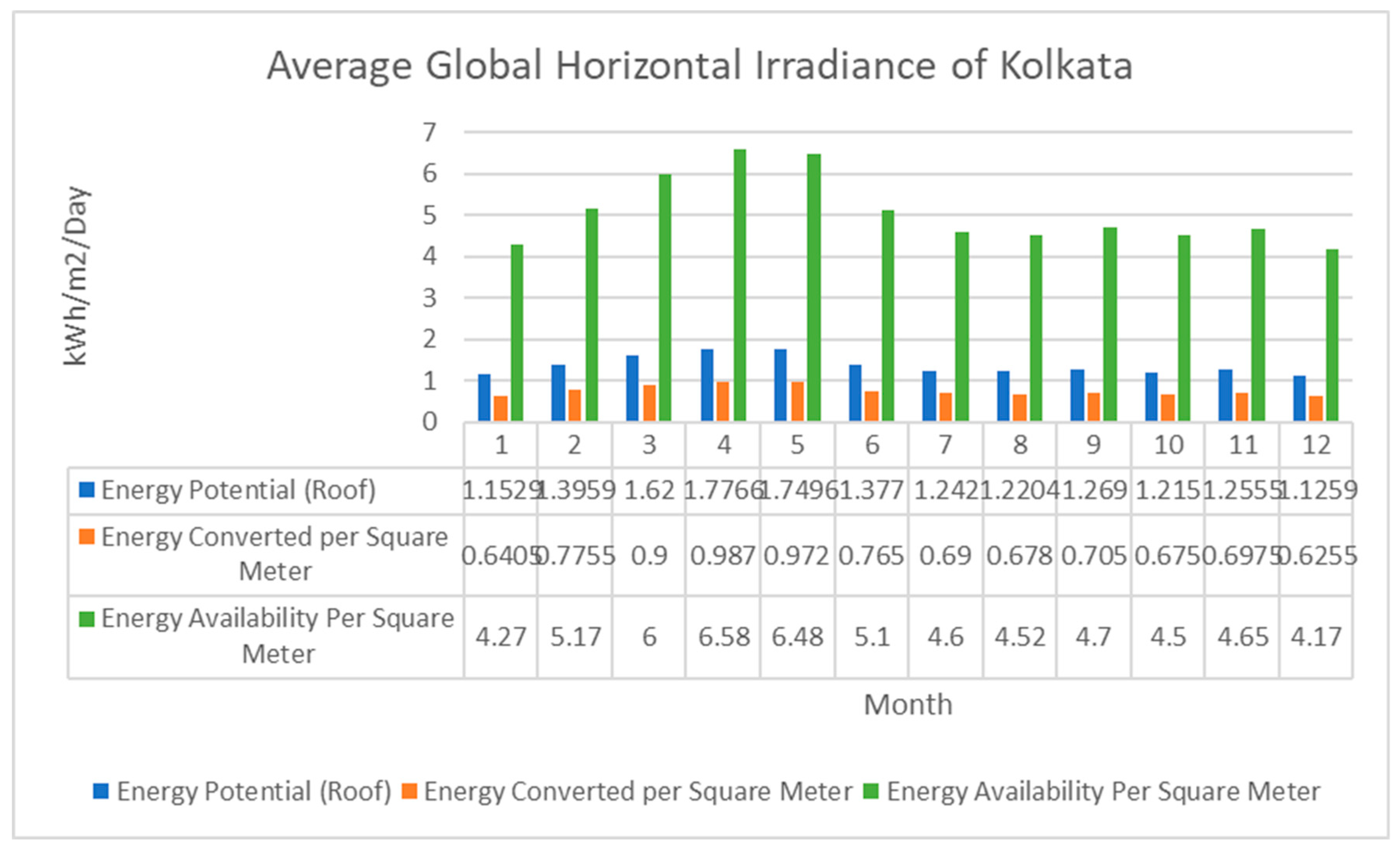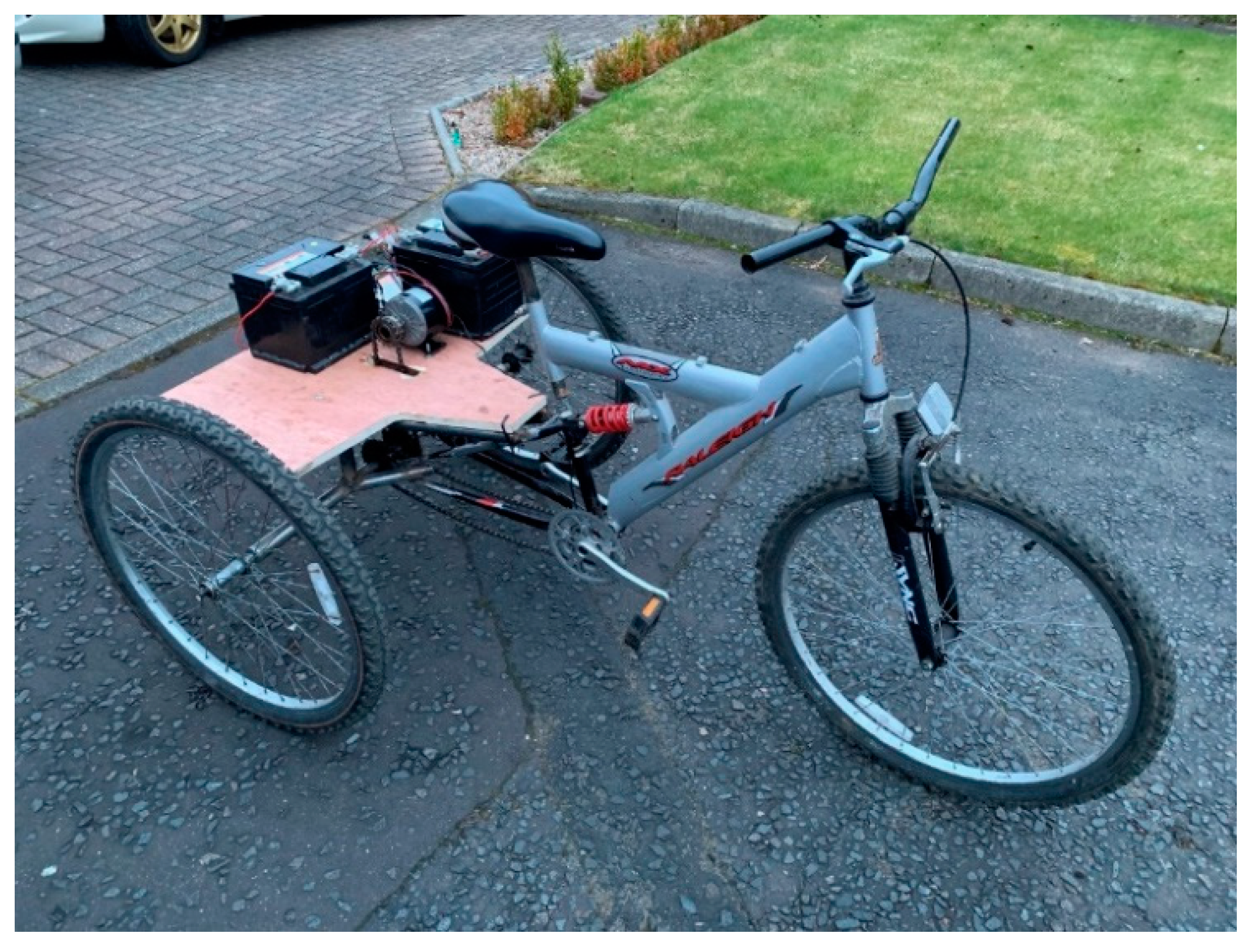Design of an Electrically Powered Rickshaw, for Use in India
Abstract
:1. Introduction
1.1. Historical Background
1.2. Population and Environment
1.3. Driver Background
1.4. Climate of India
2. Interview Data
2.1. Driver Interviews
2.1.1. Interview Design
2.1.2. Rickshaw Usage
2.1.3. Driver Profile
2.1.4. Medical Issues
2.1.5. Driver Opinion
2.2. Passenger Interviews
2.2.1. Passenger Profile
2.2.2. Passenger Opinion
2.3. Summary of Data
3. Performance Testing of the Rickshaw
3.1. Speed Testing Results
3.2. Topography Testing Results
3.3. Energy Usage
3.4. Results
4. Design Brief
5. Design
5.1. Solar
5.1.1. Solar Availability
5.1.2. Solar Farm
5.2. Funding
5.3. Electrical Components
5.3.1. Drive Systems
5.3.2. Assist Sensor
5.3.3. Control Unit
5.3.4. Motor
5.3.5. Battery
5.4. Mechanical Components
5.4.1. Gearing
5.4.2. Free Wheels
5.4.3. Wheel Size and Tyre Width
5.5. Safety
5.5.1. Seating
5.5.2. Handle
5.5.3. Collision Prevention
5.5.4. Shade Design
5.6. Servicing
5.6.1. Battery Compartment Design
5.6.2. Storage
5.7. Expected Cost
6. Proof of Concept Prototype
6.1. Development and Fabrication
6.2. Testing
6.3. Limitations
7. Evaluation
7.1. Kolkata Research and Testing
7.2. Design
7.3. Proof of Concept Prototype
8. Conclusions
9. Recommendations
Author Contributions
Funding
Conflicts of Interest
Appendix A
Appendix B
Appendix C
- It must be able to reach a speed of at least 15 km/h.
- It must have a range of at least 42 km
- It must be able to carry 2 passengers and a driver
- The rickshaw should be aesthetically pleasing and fit within the heritage.
- It must be comfortable to pedal.
- It must be designed to reduce risk of injury.
- All moving parts must be contained safely.
- It must be easy to embark and disembark for the passengers.
- The rickshaw must protect the occupants from the weather where necessary.
- It must be able to operate efficiently in the climate.
- It must be charged using solar power.
- It must be able to be manufactured in a mass quantity inexpensively.
- It must be able to be manufactured without the need for specialised machinery or tooling requiring high level workers.
- It must merit the higher cost and price to compete with the cycle rickshaw market.
- It must be able to be priced significantly cheaper than the £1100 Toto E-rickshaw [17] to avoid competition with this particular comparable vehicle.
- It must be reliable and durable.
- It must require low maintenance
- Each vehicle should have identical performance when built.
- All materials used must be capable of withstanding corrosion from the climate.
- The materials should be able to last the expected lifespan of the rickshaw or be able to be replaced inexpensively.
- The rickshaw should last over 20 years with maintenance and component replacements.
- The total vehicle weight must not exceed 150 kg.
- Must have a recharge time of less than 24 h.
- Must not exceed total weight of 40 kg.
- Must have be a usable 110 Ah of charge.
- Batteries must be easily accessible and removable.
- It must adhere to all rules and regulations for the location at which it is situated.
- The product must cost less than £350.
- No patents relating to the E-rickshaw have been found in the Indian directory.
References
- Chandran, N.; Brahmachari, S.K. Technology, knowledge and markets: connecting the dots—Electric rickshaw in India as a case study. J. Frugal Innov. 2015, 1, 2–10. [Google Scholar] [CrossRef]
- Khan, J.H.; Hassan, T. Socio-economic profile of cycle rickshaw. Eur. Sci. J. 2010, 8, 320. [Google Scholar]
- Registrar General & Census Commissioner. Census of India 2011; Registrar General & Census Commissioner: New Delhi, India, 2011. [Google Scholar]
- Goswami, D. Understanding the Socio-Economic Condition of Rickshaw Pullers: After Arrival of E-Rickshaw; University of Delhi: New Delhi, India, 2017. [Google Scholar]
- Ranjan, C.; Akhtar, S.J.; Tiwari, A.K.; Choubey, N.K.; Kumar, R.; Rajwar, L.; Kumar, N.; Kumar, R. Desing and fabrication of tri rickshaw with solar charging station. Int. J. Mech. Eng. Technol. 2017, 8, 358–366. [Google Scholar]
- Attri, S.D.; Tyagi, A. Climate Profile of India; India Meteorological Department Ministry of Earth Sciences: New Delhi, India, 2010.
- Bhattacharya, R.; Pal, S.; Bhoumick, A.; Barman, P. Annual variability and distribution of ultraviolet inder over India using temis data. Int. J. Eng. Sci. Technol. 2012, 4, 77–83. [Google Scholar]
- Muneer, T.; Kolhe, M.L.; Doyle, A. Electric Vehicles Prospects and Challenges, 1st ed.; Elsevier: Edinburgh, Scotland, 2017. [Google Scholar]
- Solar Energy Centre, MNRE, Indian Metrological Department. Typical Climatic Data for Selected Radiation Stations; Solar Energy Centre: New Dehli, India, 2008.
- Van Ditten, M. Torque Sensing for E-Bike Applications; Delft University of Technology: Delft, The Netherlands, 2011. [Google Scholar]
- Albright, G.; Edie, J.; Al-Halla, S. Comparison of Lead Acid to Lithium-ion in Stationary Storage Applications; All Cell Technologies LLC: Chicago, IL, USA, 2012. [Google Scholar]
- Hickman, M.R. A Study on Power Assists for Bicycle Rickshaws in India, including Fabrication of Test Apparatus; Massachusetts Institute of Technology: Cambridge, MA, USA, 2011. [Google Scholar]
- Steyn, W.; Warnich, J. Comparison of tyre rolling resistance for different mountain bike tyre diameters and surface conditions. S. Afr. J. Res. Sport Phys. Educ. Recreat. 2014, 36, 179–193. [Google Scholar]
- European Cyclists Federation. Requirements on Lighting (Light Intensity) and Reflectors of Bicycles; ANEC: Brussels, Belgium, 2012. [Google Scholar]
- Health and Safety Executive. Heat Stress in the Workplace; Health and Safety Executive: London, UK, 2013. [Google Scholar]
- Abbiss, C.; Peiffer, J.; Laursen, P. Optimal cadence selection during cycling. Int. Sportmed. J. 2009, 10, 1–15. [Google Scholar]
- IndiaMart. 2019. toto-e-rickshaw-16669287130. Available online: https://www.indiamart.com/proddetail/toto-e-rickshaw-16669287130.html (accessed on 2 February 2019).
















| Vehicle Characteristics | ||
|---|---|---|
| Component | Value | Unit |
| Dimensions | ||
| overall length | 2.3 | m |
| width | 1.325 | m |
| height | 1.65 | m |
| Frontal area | 2.186 | m² |
| SCx | 1.84 | m² |
| Drag Coefficient | 0.842 | |
| Load | 150 | kg |
| Standard person weight | 70 | kg |
| Simulation Inputs | ||
|---|---|---|
| Component | Value | Unit |
| Total mass (with 3 people) | 360 | kg |
| Rolling friction factor | 0.014 | |
| Density of air | 1.1644 | kg/m3 |
| Drive Type | |||
|---|---|---|---|
| Parameter | Weighting | FE | PA |
| Cost | 2 | 4 | 8 |
| Performance | 1.5 | 9 | 7 |
| Ease of Installation | 1 | 8 | 8 |
| Maintenance Required | 1.5 | 7 | 7 |
| Reliability | 2 | 8 | 9 |
| Safety | 2 | 9 | 9 |
| Range | 2 | 5 | 8 |
| Total | 77 | 90 | |
| Drive Type | ||||
|---|---|---|---|---|
| Parameter | Weighting | Aluminium | Cotton | Tarpaulin |
| Cost | 2 | 1 | 9 | 8 |
| Water Proofing | 2 | 10 | 1 | 9 |
| Ease of Installation | 1 | 8 | 9 | 9 |
| Maintenance Required | 1.5 | 10 | 4 | 7 |
| Aesthetic Value | 1 | 9 | 7 | 5 |
| UV Protection | 2 | 10 | 9 | 10 |
| Heat Barrier | 2 | 4 | 5 | 7 |
| Total | 74 | 63 | 84.5 | |
| Component | Specification | Expected Cost |
|---|---|---|
| Motor | 500W 24 V DC | £30 |
| 4 × Lead Acid Battery | 110 AH | £100 (used) |
| Cadence Sensor | N/A | £3 |
| 2 × Freewheel Sprockets | 1 × 27 T 1 × 170 T | £20 |
| 2 × Gear Sprocket | 1 × 27 T 1 × 10 T | £20 |
| Control Unit | 24 V | £9 |
| Seat Belt | N/A | £5 (used) |
| LED Lighting | 2.25 V | £2 |
| Cabling | Various amps | £1 |
| Shade Construction | Steel/Tarpaulin | £30 |
| Storage Construction | Steel/Plywood | £15 |
| Total | £235 |
© 2019 by the authors. Licensee MDPI, Basel, Switzerland. This article is an open access article distributed under the terms and conditions of the Creative Commons Attribution (CC BY) license (http://creativecommons.org/licenses/by/4.0/).
Share and Cite
Cochrane, C.; Muneer, T.; Fraser, B. Design of an Electrically Powered Rickshaw, for Use in India. Energies 2019, 12, 3346. https://doi.org/10.3390/en12173346
Cochrane C, Muneer T, Fraser B. Design of an Electrically Powered Rickshaw, for Use in India. Energies. 2019; 12(17):3346. https://doi.org/10.3390/en12173346
Chicago/Turabian StyleCochrane, Colin, Tariq Muneer, and Bashabi Fraser. 2019. "Design of an Electrically Powered Rickshaw, for Use in India" Energies 12, no. 17: 3346. https://doi.org/10.3390/en12173346
APA StyleCochrane, C., Muneer, T., & Fraser, B. (2019). Design of an Electrically Powered Rickshaw, for Use in India. Energies, 12(17), 3346. https://doi.org/10.3390/en12173346







